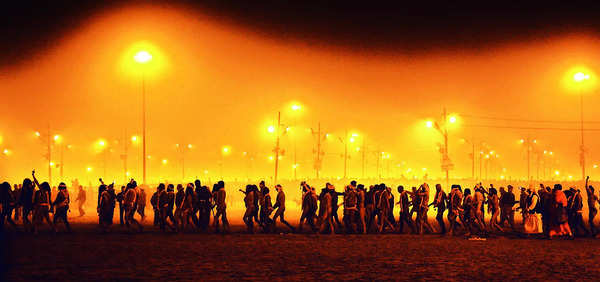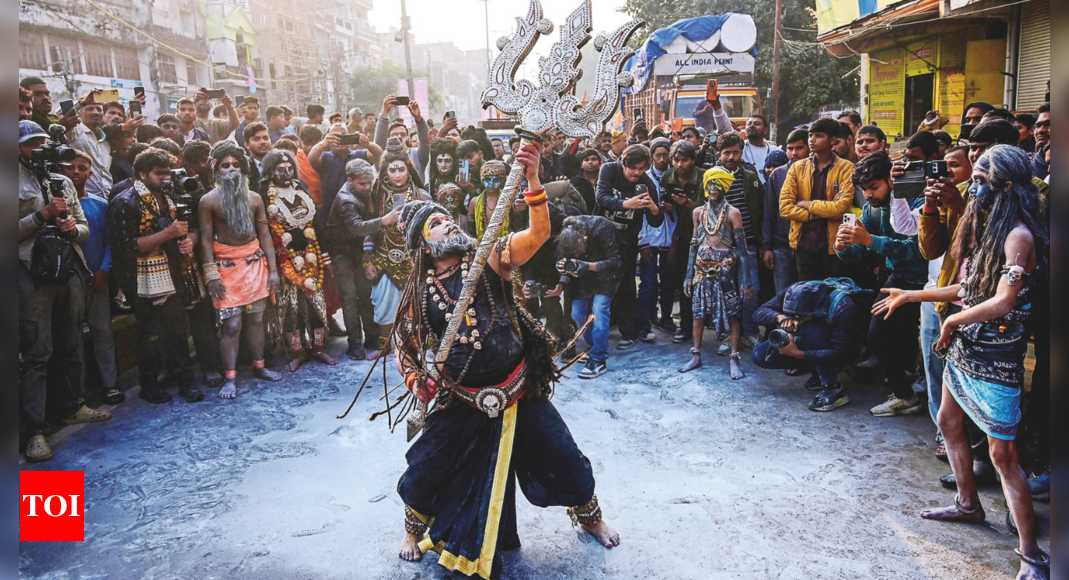A vibrant kaleidoscope of
Sanatana Dharma
will come alive during Prayagraj Maha kumbh. This pristine celebration of life and faith will also feature a Sangam of ‘akharas’. Although this Sanskrit word means wrestling field, in its deepest layers it contains many microcosms.
Shailvee Sharda
Take a look at the fascinating world.
It was the curse of Durwasa that paved the way for the Samudra Manthan and Kumbh traditions. “Once the eminent but irascible Maharishi Durwasa cursed the gods and deprived them of their powers. The demons took the opportunity to establish their reign over heaven. The aggrieved gods urged Lord Vishnu to help, who said that the lost fortunes lay in the deep layers of the ocean and advised Samudra Manthan to recover them,” says Professor Madan Mohan Pathak, professor of astrology at the Central Sanskrit University of Lucknow, citing references from Bhagwat and Vishnu Puranas. “Amrit Kumbh (vessel containing the elixir of immortality) was among the 14 gems that emerged. Desiring gods and demons entered into a tug-of-war over it. Vishnu, disguised as the sorceress Mohini, intervened and took away the Kumbh. While carrying it towards the sky, a few drops of Amrit fell into the rivers of Haridwar, Ujjain, Nashik and Prayag. Over time, the belief that those who bathe in these rivers at a cosmic moment will embrace purity, auspiciousness and immortality gave rise to the Kumbh rituals,” adds Pathak.
Akharas: Arena of the Guardians of Religion
In Sanskrit, ‘akhara’ means fighting field, but if we look closer, they are a complete microcosm that exists within the protected walls of Mathas and becomes visible during the Maha Kumbh. “The Akharas speak of a kind of social order within the ecosystem of a ‘matha’ or ‘ashram’ (an educational facility for seers) that took the responsibility of protecting the traditions of Sanatan Dharma,” explains Rana PB Singh, a retired professor of culture. Geography at Banaras Hindu University (BHU). Vedic scholar and author Mahant Mithlesh Nandini Sharan of Ayodhya points out that “it is difficult to trace the exact origin of the ‘akharas’ and calls them ‘a living proof of the Sanatan tradition.’ “The tradition of the ‘akharas’ is as old as religion itself. When seers established ‘mathas’, they often faced challenges from demons who disrupted their religious practices and rituals. Therefore, many seers raised a martial wing to protect the religion. Sanatan Dharma. Naturally, those who guarded the seers had to be in good physical shape, and the place where they practiced their skill was described as Akhara” says Mahant Mithlesh and adds, “Without Akharas, Kumbh would just be a religious fair.”

Adi Shankaracharya and Dasnami Order
The virtuous seer Adi Shankaracharya, who anchored the consolidation of Sanatan traditions in the 8th century.th century when it had divided into several warring sects, he is described as the father of the present form of Kumbh rituals.
In ‘A Story of Dasnami Naga Sanyasi’, author Jadunath Sarkar points out ten groups of seers present in the 8th century (viz. Giri, Puri, Bharti, Ban, Aranya, Parbat, Sagar, Tirtha, Ashram and Saraswati) were aligned with four ‘Mathas’ established by Adi Shankaracharya.
While the ‘Puri’, ‘Bharti’ and ‘Saraswati’ branches were linked to Sriringeri Matha (South), ‘Ban’ and ‘Aranya’ orders were aligned with Govardhan Matha in Jagannath Puri (East). ‘Giri’, ‘Parbat’ and ‘Sagar’ branches were posted to Joshi Matha (North), while ‘Tirtha’ and ‘Ashram’ branches were allotted to Sarada Math in Dwarka (West). It also marked the jurisdiction and character of each ‘matha’ and linked them into a ritual protocol, way of life and even titles.
Today, the seven Shaivite Akharas, namely Mahanirvana, Atal, Niranjani, Anand, Juna, Avahan and Agni, belong to the Dasnami order.
From Ramananacharya and Vaisnava Akharas
the 14thth The 20th century saw the birth and rise of Ramanandacharya. Born into the Kanyakubja Brahmin family of Varanasi, Ramanda walked the Vaisnava path. One of the earliest and foremost proponents of the Bhakti movement, he is also seen as a social reformer who accepted disciples without discriminating on the basis of gender, class or caste. Deans like Kabir, Ravidas, Bhagat Pipa, etc., are nicknamed his disciples and are known to belong to the Ramanandi order. Three main akharas of the Kumbh are aligned with Ramanandacharya. In his article titled ‘Akhara System in Kumbh Mela: An Epitome of Hindu Mythology’, published in the International Journal of Multidisciplinary Research, HS Bhakuni, faculty member of the history department of MB Govt PG College Uttarakhand points out that the Vaisnava sect It is grouped into Digambara, Nirmohi and Nirvani. The unique identity of these ‘akharas’ is visible in their flags, rituals and way of dressing. Their naga sanyasis dress in white.
The remaining three akharas – grouped as Udasin – are linked to Sikhism. The word udasin means neutral or impartial. Scholars noted that the followers of the Udasin order maintain the Guru or teacher as the supreme being with the idea that one cannot attain God without the guidance of the Guru. They also chose “service” as a means of salvation, while abandoning elaborate and complex rituals. They emerged in the 18thth century and the members associated with them remain committed to service. Within the akharas, they follow religious rituals only to get closer to their Guru, who would eventually help them navigate.
The stampede of 1954 and the birth of Akhara Parishad
On the Mauni Amavasya Snan of independent India’s first Kumbh, held in 1954, an unprecedented crowd of pilgrims reached the Sangam. Religious euphoria lost its limits, crowd control measures failed and caused a stampede that claimed around 800 lives and left more than 2,000 injured. An official investigation into the incident led to the formation of Akhil Bharatiya Akhara Parishad (ABAP). Since then, he has played an important role in organizing the Kumbh Melas. Currently, ABAP includes representatives of all 13 akharas and serves as the apex body of the monastic orders. Make important decisions about Kumbh Mela and address issues related to monastic orders. It also resolves disputes (if any) between them.
Sanyasin and Kinnar Akharas.
Within the larger Juna Akhara structure, a Maai Baara was created at the turn of the century. Many women ascetics who completed their 12 years of penance were ordained in 2013 Kumbh. At that time, women ascetics urged their leaders to replace ‘baara’ with ‘akhara’, as the former meant an enclosure. Thus Sanyasin Akhara was born.
Kinnar Akhara, the sect of the transgender community, also emerged in the 2016 Ujjain Kumbh. In the 2019 Kumbh Mela, around 2,000 transgender monks and seers participated under the banner of Kinnar Akhara. Acharya Mahamandaleshwar Laxmi Narayan Tripathi said that she founded the ‘akhara’ to unite transgender people, solve their problems, remove misconceptions, inform people about their rights besides spreading a message among the masses about the position of transgender people. transgender people at Sanatan Dharma. In 2019, they were accepted as part of Juna Akhara.
Initiation, rank and hierarchy
Jadunath Sarkar pointed out that the four great ‘mathas’ of the Dasnami orders have adopted certain rules of membership and organization. The Akharas do not take sanyasis directly. They must first enroll in a ‘Marhi’ (initiation centre). Many marhis combine to form an akhara.
Within each order, monks are classified according to their spiritual progress into Kutichak, Bahudak, Hansa and Paramhansa.
A Kutichali ascetic renounces the world to live in a forest. He cannot travel or beg and must survive on unsolicited donations. Bahudah is the wandering beggar who cannot stay in one place for more than three days. It collects alms in kind and cannot accept cash.
The Bhakuni renunciant must have followed the above for at least 12 years of practice.
There is no minimum age to become a sanyasi.
With penance related to control over speech, thoughts and actions, sanyasis obtain titles such as Hansa and Paramhansa and the right to possess the Dand (seen as an incarnation of God), which also has rules and regulations. For example, an ekdandi seer cannot bow only to his mother and no one else, including God.
All ‘akharas’ also have their own Naga Sadhus and Hatha Yogis.
A small act of indiscipline can lead to mandatory fasting or singing, while a moderate act can mean withdrawal of rations. Severe ones can invite expulsion for a limited time and extreme ones can mean banishment for life.
Akhara Management:
Versions of the Sannyas Upnishad are used to manage the akharas through spiritual leaders and an administrative unit.
The spiritual head is called ‘Mahamandaleshwar’ and may have a council consisting of ‘Mandaleshwar’ and ‘Mahant’.
When Akharas grew in strength, the need for many Mahamandaleshwars was felt, which paved the way for the general Acharya Mahamandaleshwar.
The administrative body that manages the ‘akhara’ is called ‘panch’ (also linked to the Panchyatan Padhyati of Adi Shankaracharya in which five gods are invoked, namely Ganesh, Vishnu, Shiva, Durga and Surya).
The group consists of five people who run the show, with ‘Sabhapati’ as the president and mahants as members. The ranks below ‘Mahant’ include ‘Karbaris’, ‘Thanapati’, ‘Sachvis’, ‘Pujaris’, ‘Kotwals’ and ‘Kotharis’ who are chosen at Kumbh Mela.





